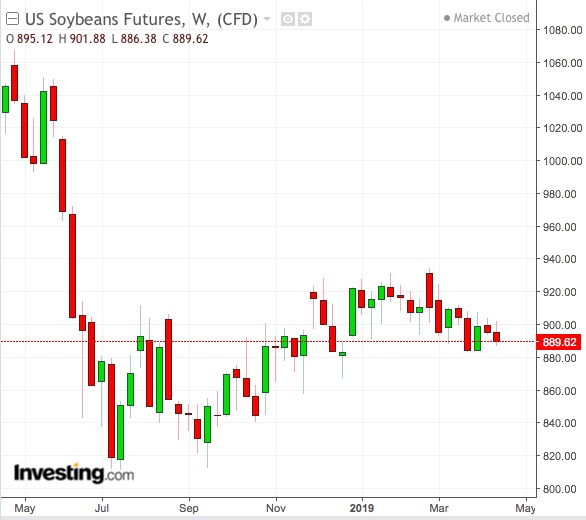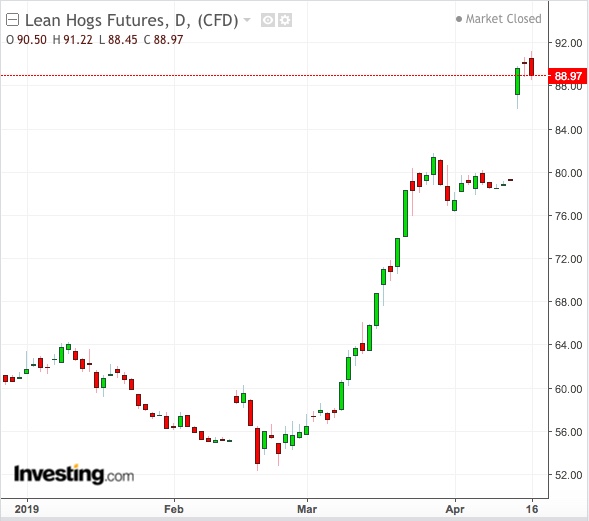Trade deal or not, it’s going to take quite a lot to restore the glory of U.S. soy products in China. And you can blame the poor pigs for that.
The dreaded African Swine Fever is obliterating China’s hog herd faster than anyone can imagine and the biggest losers at the end of the day are U.S. soy farmers.
China’s Ministry of Agriculture and Rural Affairs said over the weekend that about 18% of the country’s hog herd has been lost to the swine fever in just over eight months.
Soy Demand Plummets In China, Pork Demand Soars
The net impact of that will be less demand for soy, as one of the biggest uses of the commodity—as meal or feed for animals—will be considerably reduced in the world’s second largest economy.
Conversely, demand for hogs, or more accurately pork, will be multifold higher in China till its swine fever crises is brought under control and herds can be expanded again.
So, while headlines about the U.S. and China being “this close” and “that near” to a trade deal creates the notion that there’ll be instant relief for American soy growers once an agreement is inked and Beijing takes away its duties on U.S. farm products, the reality is actually quite different.
Trade Deal Or Not, This Is Going To Take Time To Fix

It’s going to take time and quite a bit of effort to bring both the hog and soybean markets back to where they were in China before the outbreak of the swine fever epidemic in August.
Veteran grains analyst Jack Scoville of Chicago’s Price Futures Group said the nexus between prices of pork and those of soy products cannot be understated.
Said Scoville:
“Some suggest that the total losses of hogs are equal to or greater than the combined production in North and South America combined.”
“It is an indication that U.S. soybeans and meal demand could be significantly less in the coming year as China works to eradicate the disease and then repopulate its herds.”
U.S. soybean futures are down nearly 15% from a year ago. Soymeal futures are almost 19% off in the same period.
Lean Hogs Rally Propels It To Best Performing Commodity YTD

Comparatively, U.S. lean hog futures are up a whopping 58% year-to-date, besting even gasoline’s 54% rally, to become the world’s top-performing commodity.
That’s partly because of panic buying by Chinese pork importers, rushing to lock in meat for both immediate need and forward supply, particularly from the United States.
Data shows that up to 50% of U.S. pork exports in a week now go to China as the swine fever rages in full bloom across China’s pig population.
Aside from the U.S., China has been sourcing pork and soy products from Brazil too, although soybean farmers in the South American country have become more reluctant to part with their crop lately due to a slide in the Brazilian real which has reduced their earnings.
Analysts Advise Against Going Long On Soybeans Till Demand Improves
Said Scoville:
“Soy prices are a little lower now in Brazil than in the U.S. despite a lack of farmer selling. Brazilian farmers do not like the price they’re getting. So, they are holding their crop.”
Mike Seery of Seery Futures in Plainfield, Illinois, advised investors against going long on soy products till the demand situation gets a little better.
Technically, Chicago soybean futures are trading under their 20- and 100-Day Moving Averages, with the trend clearly to the downside, after being locked in an 80-cent per bushel range over the last 6 months. As spring planting enters May, price volatility could increase substantially.
Said Seery:
“Fundamentally and technically speaking I still have a bearish bias for soybeans at this time as a 900-million bushel carryover from the last season is an overwhelming supply.”
“Couple this with the fact that the Chinese trade agreement with the United States continues to be delayed.”
